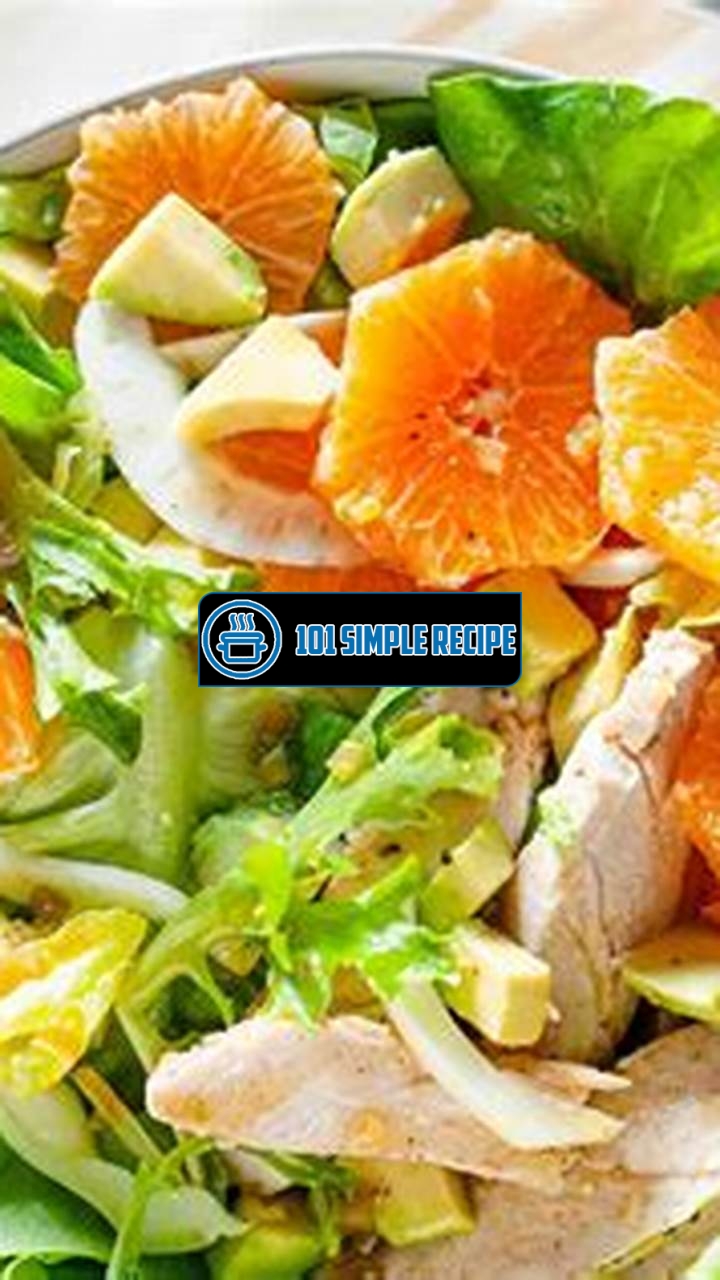Are you looking for a refreshing and satisfying salad to enjoy during the winter months? Look no further than this delicious Winter Chicken Salad with Tangy Miso Dressing. This hearty salad combines tender grilled chicken with a variety of crisp winter vegetables, making it the perfect balance of flavors and textures. The star of the dish is the tangy miso dressing, which adds a unique and zesty kick to every bite. To get your taste buds watering, just imagine the mouthwatering aroma of grilled chicken mingling with the fresh crunch of vibrant greens, roasted root vegetables, and a drizzle of tangy miso dressing. With every bite, you’ll be transported to salad heaven. So, gather your ingredients and get ready to delight your senses with this delightful winter salad!

Exploring Umami Flavors
Discover the unique taste and benefits of incorporating umami-rich ingredients into your dishes. Umami is often described as the fifth taste, alongside sweet, sour, salty, and bitter. It is a savory, meaty, and rich flavor that adds depth and complexity to any dish. In this article, we will delve into the essence of umami, explore umami-rich ingredients, and discuss the culinary uses of umami.
The Essence of Umami
Umami, originally discovered by a Japanese scientist named Kikunae Ikeda in the early 20th century, is derived from the Japanese word umai, which means delicious. It is known for its ability to enhance the overall taste of food and create a more satisfying eating experience.
At a molecular level, umami is caused by the presence of glutamate, an amino acid, and ribonucleotides, which are compounds formed from the breakdown of nucleotides. These substances react with taste receptors on our tongues, triggering a pleasurable sensation and intensifying the flavors in our mouths.
The umami taste is often associated with foods such as mushrooms, tomatoes, aged cheeses, soy sauce, and fermented products like miso and fish sauce. These ingredients are naturally rich in glutamate and ribonucleotides, making them excellent sources of umami flavor.
Umami-Rich Ingredients
When it comes to creating a winter chicken salad with tangy miso dressing, there are several umami-rich ingredients you can incorporate to enhance the flavor profile of your dish. Here are some key ingredients to consider:
- Miso paste: Made from fermented soybeans, miso paste is a staple in Japanese cuisine and adds a deep umami flavor to dressings and marinades.
- Tamari: Similar to soy sauce, tamari is a gluten-free alternative that brings a rich umami taste to your salad dressing.
- Sesame oil: Known for its nutty flavor, sesame oil adds a hint of umami and enhances the overall taste of your dressing.
- Mushrooms: Varieties like shiitake or porcini mushrooms are bursting with umami goodness and can be sautéed and tossed into your salad.
- Seaweed: Dried seaweed, such as nori or kombu, lends a unique umami flavor to your salad while providing essential nutrients.
Culinary Uses of Umami
The umami flavor can be incorporated into a wide range of culinary creations, including salads, soups, marinades, and dressings. By adding umami-rich ingredients, you can elevate the taste of your dishes and create a more satisfying eating experience.
For your winter chicken salad with tangy miso dressing, consider sautéing mushrooms in sesame oil for an extra umami boost, and adding a sprinkle of dried seaweed as a garnish. These simple additions can take your salad from ordinary to extraordinary.
In conclusion, umami is a flavor that adds depth, richness, and satisfaction to your dishes. By exploring umami flavors and incorporating umami-rich ingredients into your winter chicken salad with tangy miso dressing, you can create a truly flavorful and enjoyable meal. So go ahead, experiment with umami and let your taste buds rejoice!
If you’re in the mood for a hearty sandwich, this kaiser roll recipe is the perfect choice. Its soft texture and chewy crust make it an ideal companion to your winter chicken salad.
Revitalizing Winter Greens
During the cold winter months, it’s important to find ways to incorporate fresh and nutritious ingredients into your meals. One great option is to add winter greens to your salads. Not only do they add a vibrant burst of color, but they also provide a host of health benefits. In this article, we will explore the variety of nutritious winter greens that can add freshness to your salad, as well as some creative ways to prepare them.
Popular Winter Greens
There are several popular winter greens that you can choose from to make your salad more interesting and flavorful. Some of these include:
- Kale: Kale is a versatile winter green that can be enjoyed raw or cooked. It is known for its high vitamin C content and its ability to boost the immune system.
- Spinach: Spinach is another fantastic option that is packed with essential nutrients such as iron and folate. It has a mild taste that pairs well with a variety of ingredients.
- Swiss chard: Swiss chard is a leafy green that is often overlooked but can be a delicious addition to your salad. It is rich in vitamins A, C, and K, as well as magnesium and potassium.
- Collard greens: Collard greens are a staple in Southern cuisine and are known for their robust flavor. They are an excellent source of fiber and contain high levels of vitamins A, C, and K.
Nutritional Benefits of Winter Greens
Winter greens offer a wide range of nutritional benefits that can support your overall health. They are low in calories but high in vitamins, minerals, and antioxidants. Incorporating winter greens into your diet can help boost your immune system, improve digestion, and support healthy skin.
Additionally, winter greens are a great source of dietary fiber, which helps regulate blood sugar levels and promote a healthy digestive system. They are also rich in vitamins A, C, and K, which are essential for maintaining strong bones, good eyesight, and a healthy immune system.
Creative Ways to Prepare Winter Greens
Now that you know the variety of winter greens and their nutritional benefits, let’s explore some creative ways to prepare them:
- Incorporate them into salads: One of the simplest ways to enjoy winter greens is by adding them to your salads. Mix them with other vegetables, fruits, and protein sources for a well-rounded and nutritious meal.
- Sauté with garlic: Another delicious way to prepare winter greens is to sauté them with garlic. Heat some olive oil in a pan, add minced garlic, and then add your greens. Sauté until they are wilted and tender.
- Bake them into chips: Turn your winter greens into a healthy snack by baking them into chips. Simply toss the leaves with a little olive oil, sprinkle with salt and your favorite seasonings, and bake until crispy.
- Add them to soups and stews: Winter greens can also be added to soups and stews for added flavor and nutrition. Just chop them up and stir them into your favorite recipes.
Remember to always wash your winter greens thoroughly before using them to remove any dirt or debris.
By incorporating winter greens into your salads and meals, you can enjoy the freshness and nutrients they provide even during the colder months. Get creative with your recipes and discover new ways to enjoy these revitalizing winter greens.
Craving some cookie in a mug to enjoy alongside your tangy miso dressing? This recipe is quick, convenient, and oh so delicious. Give it a try today!
Exploring the World of Miso
In the world of culinary delights, miso is a flavorful and versatile ingredient that adds depth and complexity to a variety of dishes. This traditional Japanese seasoning is made from fermented soybeans, rice or barley, salt, and koji, a specific kind of fungus. It is no wonder that miso has garnered popularity not only in Japan but also in many other parts of the world. In this article, we will take a deep dive into the origins, types, and health benefits of miso, shining a spotlight on its role as a key ingredient in the tangy dressing of a winter chicken salad.
The History of Miso
The history of miso is deeply rooted in Japanese culture and can be traced back over a thousand years. It is believed to have originated in China and was introduced to Japan in the 7th century. Initially, miso was primarily used as a condiment and a way to preserve food. However, over time, it evolved to become a staple ingredient in many Japanese dishes.
Fun Fact: The ancient Samurai warriors considered miso a crucial part of their diet, due to its high nutritional content and energizing properties.
Types of Miso
Miso comes in a wide range of flavors, colors, and textures, making it a versatile ingredient in various cuisines. The main types of miso include:
- White Miso: This type of miso is made from soybeans that have been fermented for a relatively short period of time. It has a mild and slightly sweet flavor, making it a popular choice for dressings, marinades, and lighter soups.
- Red Miso: Fermented for a longer duration, red miso has a stronger and more robust flavor. It is often used in hearty stews, braised dishes, and miso soup.
- Yellow Miso: With a balance of sweetness and saltiness, yellow miso is a versatile choice that can be used in a variety of recipes, including glazes, stir-fries, and sauces.
- Barley Miso: This type of miso is made using barley, which gives it a distinctive flavor. It is commonly used in traditional Japanese dishes like miso soup and pickles.
Tip: Experimenting with different types of miso can add depth and complexity to your dishes, so don’t be afraid to try a variety of flavors.
Health Benefits of Miso
Miso not only adds flavor to your dishes but also brings several health benefits to the table. Here are a few reasons why miso should be a part of your diet:
- Gut Health: The fermentation process involved in making miso gives rise to probiotics, which are beneficial bacteria that promote a healthy gut microbiome.
- Nutritional Powerhouse: Miso is rich in essential nutrients, including vitamins, minerals, and amino acids, making it a great addition to a balanced diet.
- Antioxidant Properties: Miso contains antioxidants that help protect the body against cell damage caused by free radicals, reducing the risk of chronic diseases.
- Boosts Immunity: The unique combination of nutrients in miso, such as zinc and selenium, can help strengthen the immune system, keeping you healthier during the winter months.
Pro Tip: When using miso in dressings or other cooked dishes, try to add it towards the end of the cooking process to preserve more of its beneficial enzymes and probiotics.
Now that you have a better understanding of the origins, types, and health benefits of miso, you can appreciate why it is a key ingredient in the tangy dressing of a winter chicken salad. So, the next time you enjoy a flavor-packed miso-infused dish, remember the rich history and countless benefits that this humble ingredient brings to the table.
Mastering the Art of the Tangy Miso Dressing
Are you looking to elevate your winter chicken salad to a whole new level? Look no further than the tangy miso dressing. This flavorful and zesty dressing will add a delightful twist to your salad, making it a refreshing and satisfying meal option during the cold winter months.
The Key Ingredients for the Dressing
To create the perfect tangy miso dressing, you’ll need a few key ingredients that will bring out the flavors in your salad. Here’s what you’ll need:
- Miso paste: This traditional Japanese ingredient adds a rich and savory taste to the dressing. Choose a light or medium miso paste for a milder flavor or go for a dark miso paste if you prefer something more intense.
- Rice vinegar: The tanginess of rice vinegar complements the miso paste perfectly, giving the dressing a bright and zesty flavor.
- Honey: A touch of honey adds a hint of sweetness to balance out the tanginess of the dressing.
- Sesame oil: This aromatic oil adds depth and richness to the dressing. It also brings out the nutty flavors of the miso paste.
- Garlic: A clove or two of minced garlic adds a fragrant and savory note to the dressing.
- Ginger: Freshly grated ginger gives the dressing a subtle warmth and a refreshing kick.
- Water: Water helps to thin out the dressing and achieve the desired consistency.
By combining these unique flavors, you’ll create a tangy miso dressing that will take your winter chicken salad to a whole new level.
Step-by-Step Guide to Making the Dressing
Now that you have gathered the necessary ingredients, it’s time to learn how to make the tangy miso dressing step by step. Follow these instructions and you’ll have a delicious dressing in no time:
- Step 1: In a small bowl, whisk together 2 tablespoons of miso paste, 1 tablespoon of rice vinegar, 1 teaspoon of honey, 1 tablespoon of sesame oil, 1 minced garlic clove, and 1 teaspoon of freshly grated ginger.
- Step 2: Gradually add 2-3 tablespoons of water to the mixture, whisking continuously until the dressing reaches your desired consistency. If you prefer a thinner dressing, add more water.
- Step 3: Taste the dressing and adjust the flavors according to your preference. Add more miso paste for a stronger umami flavor, or more honey for added sweetness.
- Step 4: Once you are satisfied with the taste and consistency, refrigerate the dressing for at least 30 minutes to allow the flavors to meld together.
With these simple steps, you can easily prepare a flavorful and tangy miso dressing that will transform your winter chicken salad into a culinary masterpiece.
Alternative Variations of the Miso Dressing
If you’re feeling adventurous and want to explore alternative variations of the miso dressing, here are a few ideas to consider:
- Soy sauce variation: Substitute the rice vinegar with soy sauce for a deeper and saltier flavor profile.
- Lemon ginger variation: Add the juice of half a lemon and some freshly grated lemon zest to the dressing for a citrusy twist.
- Spicy Sriracha variation: Incorporate a teaspoon of Sriracha sauce into the dressing to give it a spicy kick.
Feel free to experiment with different ingredients and flavors to create a miso dressing that suits your taste buds. The possibilities are endless!
In conclusion, the tangy miso dressing is the perfect addition to your winter chicken salad. With its unique flavors and easy preparation, it will take your salad from ordinary to extraordinary. So, get creative in the kitchen and enjoy the delightful flavors of this tangy dressing all winter long!
For a delicious garlic bread stick recipe that pairs perfectly with your winter chicken salad, check out this easy-to-follow recipe. Your taste buds will thank you!
Creating a Perfect Winter Chicken Salad
Discover how to combine winter greens, tangy miso dressing, and chicken to create a satisfying and nutritious salad.
The Art of Balancing Flavors
When it comes to creating a winter chicken salad with tangy miso dressing, balancing flavors is key. The combination of winter greens, tangy miso dressing, and chicken provides a unique and delicious flavor profile. To achieve the perfect balance, it’s important to consider the taste of each component and how they complement one another.
Start by selecting a variety of winter greens. Opt for hearty options like kale, spinach, or mixed greens that can hold up well in the salad. These greens will provide a fresh and crisp base to showcase the other flavors.
Next, focus on the tangy miso dressing. Miso is a traditional Japanese seasoning made from fermented soybeans, which adds a rich umami flavor to the dressing. To achieve the right balance, whisk together miso paste, rice vinegar, sesame oil, honey, and a touch of soy sauce. Adjust the amounts of each ingredient to your preference, adding more sweetness or acidity as needed.
Lastly, the star of the show – the chicken. Choose a lean protein like grilled or roasted chicken breast. Season it with salt, pepper, and any desired herbs or spices. Cook it to perfection and slice it thinly before adding it to the salad.
When combining the ingredients, start with a bed of winter greens and then layer the chicken on top. Drizzle the tangy miso dressing over the salad and toss gently to ensure every bite is coated in flavor. Use tongs or salad servers to mix everything together without bruising the delicate greens.
Additions and Substitutions for the Salad
While the combination of winter greens, tangy miso dressing, and chicken is a winning formula for a winter chicken salad, there are also a variety of additions and substitutions you can make to suit your taste preferences or dietary needs.
Additions:
- Add roasted butternut squash or sweet potatoes for a touch of sweetness and added texture.
- Toss in some toasted nuts like almonds or walnuts for a crunchy element.
- Sprinkle pomegranate seeds or dried cranberries for a burst of tangy flavor.
- Garnish with fresh herbs like cilantro, mint, or parsley to add brightness.
Substitutions:
- If you’re vegetarian or vegan, swap the chicken for grilled tofu or tempeh.
- For a different twist on the dressing, use tahini or peanut butter instead of miso paste.
- Experiment with different winter greens like arugula, Swiss chard, or radicchio.
- Try using a different protein like grilled shrimp or seared salmon.
Tips for Assembling the Perfect Salad
In order to create the perfect winter chicken salad with tangy miso dressing, here are some helpful tips:
- Make sure to wash and thoroughly dry the winter greens before assembling the salad. This will ensure they are clean and crisp.
- Slice the chicken thinly and evenly to ensure it is distributed well throughout the salad.
- When making the tangy miso dressing, taste and adjust the flavors as needed. You may prefer it slightly sweeter, tangier, or more savory.
- Add the dressing to the salad just before serving to prevent the greens from becoming soggy.
- Use fresh and high-quality ingredients to enhance the taste and overall quality of the salad.
With these tips in mind, you’re ready to create a perfect winter chicken salad with tangy miso dressing. Enjoy the delicious combination of flavors and the nutritious benefits of this satisfying salad!
Thank you for taking the time to read our article on the winter chicken salad with tangy miso dressing. We hope you found the recipe and tips helpful in creating a delicious and nutritious meal. Make sure to visit our website again for more tasty recipes and culinary inspiration. Stay warm and enjoy your winter chicken salad!
Frequently Asked Questions
Here are some frequently asked questions about our winter chicken salad with tangy miso dressing:
| No. | Questions | Answers |
|---|---|---|
| 1. | What is miso dressing? | Miso dressing is a flavorful sauce made from fermented soybeans. It adds a tangy and savory taste to salads and other dishes. |
| 2. | Can I use a different protein in this salad? | Yes, you can substitute the chicken with tofu, shrimp, or even roasted vegetables for a vegetarian option. |
| 3. | What are some good substitutions for the dressing? | If you don’t have miso, you can try using soy sauce or tahini for a different flavor profile. |
| 4. | How long can I store the salad? | The salad can be stored in the refrigerator for up to 2 days. Make sure to keep the dressing separate until ready to serve. |
| 5. | Can I adjust the spiciness of the dressing? | Absolutely! You can add more or less sriracha sauce to adjust the level of spiciness according to your preference. |
| 6. | Is this salad suitable for a gluten-free diet? | Yes, the salad is gluten-free as long as you use gluten-free soy sauce or tamari in the dressing. |
Closing Thoughts
We hope you enjoyed learning about our winter chicken salad with tangy miso dressing. It’s a flavorful and satisfying dish that is perfect for the colder months. Don’t forget to save this recipe and come back to our website for more delicious ideas. Stay warm and happy cooking!
Jump to Recipe
Winter Chicken Salad with Tangy Miso Dressing

A delicious and nutritious winter salad recipe featuring chicken and a tangy miso dressing.
- 2 boneless (skinless chicken breasts)
- 6 cups mixed salad greens
- 1 cup shredded carrots
- 1 cup sliced cucumber
- 1/4 cup chopped green onions
- 1/4 cup chopped cilantro
- 1/4 cup roasted peanuts
- 2 tablespoons sesame seeds
- 1/4 cup olive oil
- 2 tablespoons rice vinegar
- 1 tablespoon miso paste
- 1 tablespoon honey
- 1 tablespoon soy sauce
- 1 tablespoon sriracha sauce
- Preheat the oven to 400°F. Season the chicken breasts with salt and pepper. Place them on a baking sheet and roast for 15 minutes or until cooked through. Let cool, then shred the chicken into bite-sized pieces.
- In a small bowl, whisk together the olive oil, rice vinegar, miso paste, honey, soy sauce, and sriracha sauce until smooth and well combined.
- In a large bowl, combine the mixed salad greens, shredded carrots, sliced cucumber, green onions, and cilantro. Add the shredded chicken and toss to combine. Drizzle the miso dressing over the salad and toss again to coat. Top with roasted peanuts and sesame seeds.
- Divide the salad among plates or bowls. Serve immediately and enjoy!






